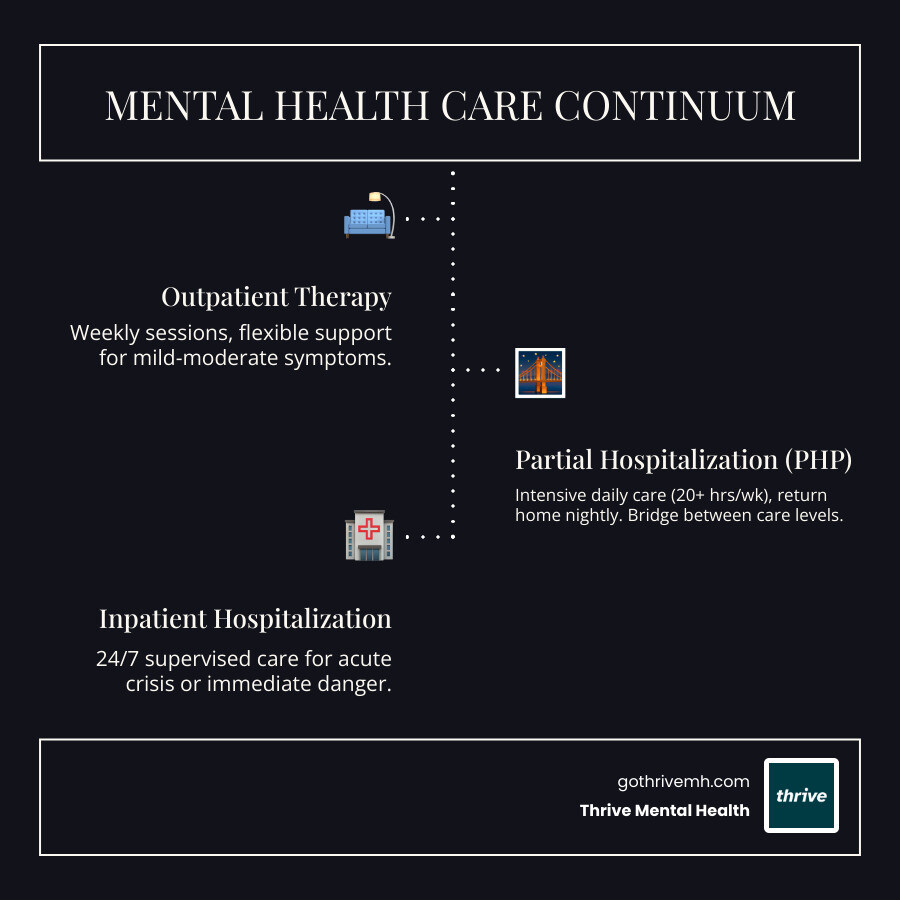What the PHP? Understanding Partial Hospitalization for Mental Health

Why PHP Mental Health Services Are Changing Mental Health Care
PHP mental health services offer intensive, structured treatment for those who need more support than weekly therapy but don’t require 24-hour inpatient care. These programs bridge a critical gap, helping people stabilize symptoms while maintaining their daily routines.
Quick Overview: PHP Mental Health Services
- What it is: A structured outpatient program with 20+ hours of weekly treatment.
- Who it’s for: Individuals needing intensive support who can return home nightly.
- Schedule: 4-6 hours daily, 5-7 days per week.
- Services: Individual and group therapy, medication management, psychiatric care.
- Goal: To stabilize symptoms and prevent inpatient hospitalization.
When mental health challenges feel overwhelming, traditional therapy may not be enough, while hospitalization can feel too disruptive. PHP fills this crucial gap. It provides structured, daily support for those who want to sleep in their own bed each night. Whether stepping down from a higher level of care or stepping up from outpatient therapy, PHP delivers the intensive treatment needed to build lasting coping skills.
Modern PHP programs are also flexible. Virtual options make this level of care accessible from home, removing barriers like transportation and scheduling conflicts.
As CEO of Thrive Mental Health, I’ve seen PHP mental health services transform lives by providing the right intensity of care at the right time. When people receive appropriate, structured support, they can achieve remarkable healing while maintaining their daily responsibilities.

What Exactly is a Partial Hospitalization Program (PHP)?

A Partial Hospitalization Program (PHP) is an intensive, structured mental health treatment that bridges the gap between inpatient hospitalization and traditional outpatient therapy. It provides hospital-level care during the day while you return home each night.
PHP mental health services are a powerful alternative to inpatient care, helping you stabilize symptoms and develop coping skills without disrupting your entire life. The goal is to provide intensive support to help you regain stability and prevent the need for more restrictive care. Unlike weekly therapy, PHP requires a significant time commitment—typically 20+ hours per week. This intensity creates a structured environment for meaningful change. A review of PHPs found them to be a cost-effective option for those who need more than weekly therapy but not 24-hour supervision.
You receive comprehensive care from a multidisciplinary team (psychiatrists, therapists, case managers) while maintaining connections to home and family. This approach helps you practice new skills in real-world situations. Modern virtual options have also made this level of care more accessible than ever. For more details, you can explore More info about our PHP Program.
The Primary Purpose and Goals of a PHP
The core of PHP is providing intensive support to create a structured environment for healing from conditions like depression, anxiety, and trauma.
- Symptom management: Stabilize acute symptoms through daily therapeutic interventions and medication management.
- Developing coping skills: Learn and practice evidence-based strategies to manage stress, regulate emotions, and handle difficult situations.
- Improving daily functioning: Regain the ability to manage self-care, work, and relationships.
- Preventing relapse: Build resilience and receive consistent support to maintain long-term progress.
- Transitioning to a lower level of care: Serve as a stepping stone to the next phase of your recovery journey.
- Building a support system: Form vital connections through group and family therapy that extend beyond the program.
Who is an Ideal Candidate for a PHP?
PHP is best for individuals who need intensive support but can safely return home each night. You may be a good fit if you are:
- Struggling with daily activities like self-care, work, or relationships due to mental health symptoms.
- Needing more structure than weekly therapy can provide to create lasting change.
- Not an immediate danger to self or others, meaning you don’t require 24/7 medical supervision.
- In a stable home environment that is safe and supportive of your recovery.
- Medically stable, with any physical health conditions managed and not requiring constant monitoring.
- Transitioning from a higher level of care, such as inpatient treatment, and need structured support.
- Managing co-occurring disorders, such as mental health and substance use issues, which can be addressed simultaneously.
A Day in the Life: The Structure and Services of a PHP

In a PHP mental health services program, your day is focused on healing. Programs typically run for 4 to 6 hours daily, 5 to 7 days per week, adding up to the 20+ hours per week needed for intensive treatment and lasting change.
Each hour is carefully planned to advance your recovery. A typical day might include group therapy, individual counseling, a psychoeducational workshop, and a mindfulness practice. This structured programming is guided by a multidisciplinary team of psychiatrists, licensed therapists, and case managers who collaborate on your care.
This intensive structure allows you to practice new coping skills throughout the day and get immediate feedback, all while having a support network to help you work through challenges. For a deeper dive, check out our Guide to Partial Hospitalization Programs.
What Therapies Are Included in PHP Mental Health Services?
We offer a comprehensive menu of evidence-based treatments custom to your specific needs, rather than a one-size-fits-all approach.
- Individual therapy: One-on-one sessions to explore personal challenges and develop personalized coping strategies.
- Group therapy: A powerful setting to share experiences, gain peer support, and realize you’re not alone.
- Family therapy: When appropriate, sessions can improve communication and build a stronger support system at home.
- Cognitive Behavioral Therapy (CBT): Helps you identify and change negative thought patterns.
- Dialectical Behavior Therapy (DBT): Teaches skills for managing intense emotions, improving relationships, and tolerating distress.
- Experiential therapies: Includes art therapy or movement practices to express emotions and reconnect with your body.
- Medication management: Our psychiatrists conduct evaluations, prescribe medications when helpful, and monitor your response.
- Psychoeducation: Empowers you with knowledge about your condition, triggers, and effective management strategies.
The Rise of Flexible Treatment: Virtual PHPs
The rise of virtual PHP programs has been a game-changer, making intensive treatment more accessible than ever. What once required daily travel to a center can now be accessed from the comfort of your home.
This shift removes barriers for those in rural areas, parents with childcare needs, or individuals whose anxiety makes leaving home difficult. You can maintain daily responsibilities while receiving expert-led care, attending sessions without the stress of a commute. Our virtual programs uphold the same rigorous standards and multidisciplinary approach as our in-person options, using technology to bridge the gap to the care you need. Learn more about our approach in Thrive’s Virtual PHP Treatment Program Approach.
PHP vs. Other Levels of Care: A Clear Comparison

Understanding your options on the mental health continuum of care is key. Each level offers different support, and you may need to step up or down depending on your needs. PHP mental health services occupy a crucial middle ground, bridging the gap between 24/7 inpatient treatment and less frequent outpatient therapy.
A professional assessment can help determine the right level of care for you by evaluating your symptoms, daily functioning, and support system. For a closer look at similar programs, our PHP vs IOP: A Detailed Comparison offers an in-depth analysis.
PHP vs. Inpatient vs. Intensive Outpatient (IOP)
Understanding the key differences between these levels of care helps you make an informed decision.
- Inpatient Treatment: The highest level of care, providing 24/7 medical and psychiatric supervision in a hospital. It’s for individuals in severe crisis who are an immediate risk to themselves or others.
- Partial Hospitalization Program (PHP): High-intensity treatment with 20-30 hours of structured programming per week. You receive daily medical oversight but return home each night. The goal is to prevent hospitalization or serve as a step-down from inpatient care.
- Intensive Outpatient Program (IOP): Moderate-intensity treatment requiring 9-12 hours per week. It focuses on structured support and applying skills while you manage more of your daily life independently.
This continuum is flexible, allowing you to move between levels as your needs change. For more details on outpatient options, see What is the Difference Between PHP and IOP?.
What Are the Benefits of PHP Mental Health Services?
The advantages of a PHP create lasting change by addressing mental health from multiple angles.
- Comprehensive care: A multidisciplinary team (psychiatrists, therapists, case managers) collaborates on all aspects of your treatment.
- Structured environment: A predictable, safe daily schedule provides grounding when your internal world feels chaotic.
- Medical monitoring: Access to psychiatric evaluations and medication management allows for prompt treatment adjustments.
- Real-world application of skills: You immediately practice coping strategies learned in therapy in your daily life, reinforcing progress.
- Cost-effective alternative to inpatient care: Provides a high level of treatment without the cost of 24/7 residential stays.
- Peer support: Group therapy reduces isolation and provides invaluable encouragement from others with similar experiences.
- Continuity of care: PHP serves as a seamless bridge between different treatment levels, maintaining recovery momentum.
Navigating the Logistics: Cost, Insurance, and Finding PHP Mental Health Services

Figuring out the financial side of treatment can be overwhelming. Understanding the cost and insurance landscape for PHP mental health services is a crucial first step.
PHP costs vary by location, program length, and included services. It’s important to understand what’s covered, such as medications or special assessments. Most people use private insurance, where the difference between in-network and out-of-network providers can be significant. Verifying your benefits with your insurance company beforehand is essential to avoid unexpected bills. For those without full coverage, many programs offer self-pay options or payment plans.
Is Partial Hospitalization Covered by Medicare and Other Insurance?
PHP mental health services are generally covered under Medicare Part B, but specific requirements must be met. A doctor must certify that PHP is medically necessary to prevent an inpatient stay. The program must also be provided through an approved setting, like a community mental health center or hospital outpatient department, and include at least 20 hours of therapeutic services per week.
You will still be responsible for coinsurance and deductibles. After meeting your Part B deductible, you typically pay a percentage of the Medicare-approved amount. Services like meals and transportation are not usually covered. Private insurance and Medicaid coverage for PHP vary by plan and state, so always check your specific policy.
How to Find a Suitable Program
Finding the right PHP is easier with a clear strategy.
- Consult a mental health professional: Your therapist, doctor, or psychiatrist can assess your needs and recommend reputable local programs.
- Use online resources: The SAMHSA treatment locator is an excellent tool for searching by location, service type, and payment options.
- Ask for a referral: Professionals in the mental health field often have insider knowledge about which programs deliver the best outcomes.
- Research potential programs: When you find a program, ask detailed questions to ask providers. Inquire about their therapies, daily schedule, treatment team, and experience with conditions like yours. Clarify all costs, insurance acceptance, and payment options.
Organizations like the National Alliance on Mental Illness (NAMI) also offer support and guidance for navigating the mental health system.
Frequently Asked Questions about PHP
It’s natural to have questions when considering PHP mental health services. Here are answers to some common concerns.
How long does a typical PHP program last?
There’s no one-size-fits-all answer. The length of your program depends on your individual needs, progress, and goals. Some people are ready to transition to a lower level of care after a few weeks, while others may benefit from several months of support.
Your treatment team will work closely with you, regularly assessing your progress in a collaborative process. The goal is to ensure you have built the skills and stability needed to succeed at the next level of care without rushing or unnecessarily extending your time in the program.
Can I work or go to school while in a PHP?
This is a common concern. PHP mental health services require a significant time commitment—typically 20 or more hours per week—which can make juggling work or school challenging, but not always impossible.
Many people arrange flexible schedules, take medical leave, or work part-time. Virtual PHP programs have been a game-changer, eliminating commute times and offering more flexibility to balance responsibilities. However, it’s important to prioritize your recovery, as over-committing can interfere with your progress. We encourage open conversations with your employer or school to explore your options.
What happens after I complete a PHP?
Completing a PHP is a major achievement, but it’s a chapter in your journey, not the final destination. Most people transition to traditional outpatient therapy, such as weekly sessions with a therapist and continued medication management.
Before you finish, we work with you to create a solid aftercare plan. This roadmap for continued recovery includes therapy recommendations, relapse prevention strategies, and connections to community support groups. The skills you learned in PHP are yours to keep, providing a toolkit to help you maintain progress and continue building the life you want. To learn more about the next steps, read about The Benefits of an Intensive Outpatient Program.
Taking the Next Step Toward Healing
We hope this guide has clarified what PHP mental health services offer and why they are a vital part of the mental health care continuum. These programs provide a unique bridge, connecting intensive healing with the life you want to live.
PHP offers the structured, intensive support you need during a difficult time, while still allowing you to sleep in your own bed. This balance is what makes it so effective for those who need more than weekly therapy but don’t require 24-hour hospitalization. Whether you’re stepping up from outpatient therapy or down from a higher level of care, PHP provides the treatment needed to regain stability and build lasting coping skills.
For those seeking flexible, evidence-based care, options like Thrive Mental Health’s virtual and in-person programs provide a modern approach to this level of support. Our commitment to expert-led treatment ensures you get the right care, custom to your needs and accessible from wherever you feel most comfortable.
Seeking help is a sign of strength. Empowerment through treatment isn’t just possible—it’s what happens when you receive the right intensity of care at the right time. If you’re still weighing your options, we encourage you to learn more about the differences between PHP and IOP to find the right fit for you.
Your path to wellness is unique, and the right support can make all the difference. We’re here to provide the structured care and compassionate guidance you need to not just survive, but truly thrive.
2 thoughts on “What the PHP? Understanding Partial Hospitalization for Mental Health”
Comments are closed.